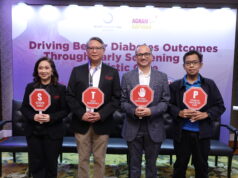“It’s not just breast cancer that kills women,” said Dr. Maria Adelaida Iboleon-Dy, chairman of the cardiology department at St. Luke’s Medical Center in Quezon city.
Global records have shown that since 1992, cardiovascular diseases (CVDs) have eclipsed infectious diseases as one of the causes of death of women. She noted that, according to a study released during World Heart Day in 2014, 8.6 million women die from heart diseases every year, thus making it a greater a killer of women than breast cancer (or any other kind of cancer for that matter).
More women than men also die of heart attacks, Dr. Iboleon-Dy said during a press conference on Nov. 24 at Discovery Primea in Makati City. “Thirty-eight percent of women compared with 25% of men will die within one year after a heart attack,” she said.
“More women (since 1984) died of heart diseases, partly because women are more difficult to diagnose and partly because women are not as likely to get appropriate treatment following a first heart attack,” she said before adding that women usually get help late because of the different symptoms they might experience from the usual chest pain (angina) and shortness of breath.
Some of the symptoms women experience include anxiety or a “doomed” feeling, suddenly becoming very tired, a burning abdominal pain, or vomiting, all of which women tend to dismiss as just fatigue or gastritis.
Women tend to develop these problems 10 years after men (between the ages of 51-70), after they reach menopause — estrogen is believed to keep the blood vessels flexible, thus lowering their chance of having any blockages before this time.
Differing pain thresholds also make it difficult for women to recognize that they are having a heart attack. Dr. Iboleon-Dy noted that women often rate chest pains leading to heart diseases as “mild to severe” while men rate theirs as “severe.”
Women also have lower levels of Troponin-I — a protein which is found in the heart muscles and which is released into the blood when there is damage to the heart. Blood tests measure levels of Troponin-I to detect if a person is having a heart attack. Most current tests do not discriminate between genders and cannot precisely measure very low levels of the protein.
Abott Laboratories has introduced a new test to diagnose and/or rule out heart attacks which differentiates between troponin levels of men and women for more precise results.
The ARCHITECT STAT High Sensitive Troponin-I (hsTNl) “may rule out heart attacks to help doctors promptly discharge two-thirds of patients with chest pain… due to the improved precision at detecting low levels of troponin in the blood,” says a company press release. Patients may be able to avoid a prolonged wait for additional testing or longer hospital stay as current tests are sometimes done upon admission, six hours and potentially 12 hours later before a diagnosis may be made which isn’t ideal as “the length of time to diagnosis is a crucial factor because the heart muscle cells start to dies after the heart stops receiving blood, and eventually, almost all the affected parts of the heart could be irreversibly damaged,” said the press release.
Currently the test is offered in Medical City, De La Salle University Medical Center, and the Victor R. Potenciano Medical Center, and will soon be offered in the Philippine Heart Center, among other hospitals. — Zsarlene B. Chua
Illustration: Freepik.com



